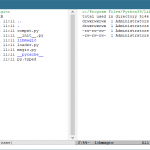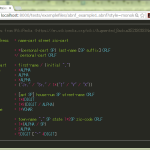Parsing In Python: Tools And Libraries より。
竜 TatSu。Arpeggioと同じく PEG 系。そしてここまでみてきた PEG 系とは明らかに異端、だけれども、初見での第一印象は「最もフレキシブルで完成度も高そう」というもの。
異端:
EBNF (の変種?) から PEG パーサを生成する、ということは、「orderd choice」でパーサの振る舞いが変わりうる、ということだと思うが、この差異は脳内変換せよ、ちぅこと? ながーい rational に書かれてるかもしれんけど長過ぎて読む気になれない。
というわけで構文の定義は EBNF (の変種)でこんな具合らしい:
1 GRAMMAR = '''
2 @@grammar::Calc
3
4 start = expression $ ;
5
6 expression
7 =
8 | term '+' ~ expression
9 | term '-' ~ expression
10 | term
11 ;
12
13 term
14 =
15 | factor '*' ~ term
16 | factor '/' ~ term
17 | factor
18 ;
19
20 factor
21 =
22 | '(' ~ @:expression ')'
23 | number
24 ;
25
26 number = /\d+/ ;
27 '''
随分拡張されているようで、本物の EBNF だけ知っててもこれは想像もつかんわな。
さて、「竜 TatSu」がフレキシブルだ、について。すなわち、「あたかも re モジュール」的ノリで使われることを想定してんのね:
1 # -*- coding: utf-8 -*-
2 import tatsu
3
4 # the grammar of my calc
5 GRAMMAR = '''
6 @@grammar::Calc
7
8 start = expression $ ;
9
10 expression
11 =
12 | term '+' ~ expression
13 | term '-' ~ expression
14 | term
15 ;
16
17 term
18 =
19 | factor '*' ~ term
20 | factor '/' ~ term
21 | factor
22 ;
23
24 factor
25 =
26 | '(' ~ @:expression ')'
27 | number
28 ;
29
30 number = /\d+/ ;
31 '''
32
33 # like "rgx = re.compile(r'...')"
34 calcp = tatsu.compile(GRAMMAR, name="Calc")
35 print(calcp.parse("3 + 2 - (1 + 3 * 4)"))
無論 re モジュールのノリと同じで、
1 # like "re.match(r'...', '...')"
2 print(tatsu.parse(GRAMMAR, "3 + 2 - (1 + 3 * 4)"))
もオケ。さらにはコンパイル済みパーサを「python モジュールとして」書き出せる:
1 # generate parser as python module
2 open("mycalc.py", "w").write(
3 tatsu.to_python_sourcecode(GRAMMAR, name="mycalc"))
まぁ「自分の製品が動的に python モジュールを吐き出して動作する」というもんは作らんよねフツーは。Windows ならともかく、Unix でシステムインストールされるようなライブラリを書くつもりなら、モジュールを書き出す場所がないでしょ。そうではなくて「tatsu を静的ジェネレータとして使いたいならば」ということよね。ともあれ tatsu.to_python_sourcecode はこんな python コードを生成してくれた:
1 #!/usr/bin/env python
2 # -*- coding: utf-8 -*-
3
4 # CAVEAT UTILITOR
5 #
6 # This file was automatically generated by TatSu.
7 #
8 # https://pypi.python.org/pypi/tatsu/
9 #
10 # Any changes you make to it will be overwritten the next time
11 # the file is generated.
12
13
14 from __future__ import print_function, division, absolute_import, unicode_literals
15
16 from tatsu.buffering import Buffer
17 from tatsu.parsing import Parser
18 from tatsu.parsing import tatsumasu
19 from tatsu.util import re, generic_main # noqa
20
21
22 KEYWORDS = {} # type: ignore
23
24
25 class mycalcBuffer(Buffer):
26 def __init__(
27 self,
28 text,
29 whitespace=None,
30 nameguard=None,
31 comments_re=None,
32 eol_comments_re=None,
33 ignorecase=None,
34 namechars='',
35 **kwargs
36 ):
37 super(mycalcBuffer, self).__init__(
38 text,
39 whitespace=whitespace,
40 nameguard=nameguard,
41 comments_re=comments_re,
42 eol_comments_re=eol_comments_re,
43 ignorecase=ignorecase,
44 namechars=namechars,
45 **kwargs
46 )
47
48
49 class mycalcParser(Parser):
50 def __init__(
51 self,
52 whitespace=None,
53 nameguard=None,
54 comments_re=None,
55 eol_comments_re=None,
56 ignorecase=None,
57 left_recursion=True,
58 parseinfo=True,
59 keywords=None,
60 namechars='',
61 buffer_class=mycalcBuffer,
62 **kwargs
63 ):
64 if keywords is None:
65 keywords = KEYWORDS
66 super(mycalcParser, self).__init__(
67 whitespace=whitespace,
68 nameguard=nameguard,
69 comments_re=comments_re,
70 eol_comments_re=eol_comments_re,
71 ignorecase=ignorecase,
72 left_recursion=left_recursion,
73 parseinfo=parseinfo,
74 keywords=keywords,
75 namechars=namechars,
76 buffer_class=buffer_class,
77 **kwargs
78 )
79
80 @tatsumasu()
81 def _start_(self): # noqa
82 self._expression_()
83 self._check_eof()
84
85 @tatsumasu()
86 def _expression_(self): # noqa
87 with self._choice():
88 with self._option():
89 self._term_()
90 self._token('+')
91 self._cut()
92 self._expression_()
93 with self._option():
94 self._term_()
95 self._token('-')
96 self._cut()
97 self._expression_()
98 with self._option():
99 self._term_()
100 self._error('no available options')
101
102 @tatsumasu()
103 def _term_(self): # noqa
104 with self._choice():
105 with self._option():
106 self._factor_()
107 self._token('*')
108 self._cut()
109 self._term_()
110 with self._option():
111 self._factor_()
112 self._token('/')
113 self._cut()
114 self._term_()
115 with self._option():
116 self._factor_()
117 self._error('no available options')
118
119 @tatsumasu()
120 def _factor_(self): # noqa
121 with self._choice():
122 with self._option():
123 self._token('(')
124 self._cut()
125 self._expression_()
126 self.name_last_node('@')
127 self._token(')')
128 with self._option():
129 self._number_()
130 self._error('no available options')
131
132 @tatsumasu()
133 def _number_(self): # noqa
134 self._pattern(r'\d+')
135
136
137 class mycalcSemantics(object):
138 def start(self, ast): # noqa
139 return ast
140
141 def expression(self, ast): # noqa
142 return ast
143
144 def term(self, ast): # noqa
145 return ast
146
147 def factor(self, ast): # noqa
148 return ast
149
150 def number(self, ast): # noqa
151 return ast
152
153
154 def main(filename, startrule, **kwargs):
155 with open(filename) as f:
156 text = f.read()
157 parser = mycalcParser()
158 return parser.parse(text, startrule, filename=filename, **kwargs)
159
160
161 if __name__ == '__main__':
162 import json
163 from tatsu.util import asjson
164
165 ast = generic_main(main, mycalcParser, name='mycalc')
166 print('AST:')
167 print(ast)
168 print()
169 print('JSON:')
170 print(json.dumps(asjson(ast), indent=2))
171 print()
生成されたこれをモジュールとして使うには無論こう:
1 # -*- coding: utf-8 -*-
2 import mycalc # my parser, was generated by tatsu
3
4 parser = mycalc.mycalcParser()
5 print(parser.parse("3 + 2 - (1 + 3 * 4)"))
パーサではなく「オブジェクトモデルとして」書き出すことも出来る、とあるが、どういう意味だ? 実際やってみると:
1 # generate model as python module
2 open("mycalcmodel.py", "w").write(
3 tatsu.to_python_model(GRAMMAR, name="mycalcmodel"))
こんなん出ました:
1 #!/usr/bin/env python
2 # -*- coding: utf-8 -*-
3
4 # CAVEAT UTILITOR
5 #
6 # This file was automatically generated by TatSu.
7 #
8 # https://pypi.python.org/pypi/tatsu/
9 #
10 # Any changes you make to it will be overwritten the next time
11 # the file is generated.
12
13 from __future__ import print_function, division, absolute_import, unicode_literals
14
15 from tatsu.objectmodel import Node
16 from tatsu.semantics import ModelBuilderSemantics
17
18
19 class mycalcmodelModelBuilderSemantics(ModelBuilderSemantics):
20 def __init__(self):
21 types = [
22 t for t in globals().values()
23 if type(t) is type and issubclass(t, ModelBase)
24 ]
25 super(mycalcmodelModelBuilderSemantics, self).__init__(types=types)
26
27
28 class ModelBase(Node):
29 pass
うーん、多分 tatsu.to_python_sourcecode と tatsu.to_python_model に渡す name は同じものにするのが正解だろうな。にしてもこれはなんだろうか。Semantic Actions に関係してることはさすがにわかるが、何に使うのだろう? まだわかんない。
さて。その Semantic Actions だが、ものによっては戻りをそのまま自力でトラバースしちゃった方がラクなケースも多そうだ。今例にしてるヤツだと:
1 # -*- coding: utf-8 -*-
2 import mycalc # my parser, was generated by tatsu
3
4 parser = mycalc.mycalcParser()
5 print(parser.parse("3 + 2 - (1 + 3 * 4)"))
1 [u'3', u'+', [u'2', u'-', [u'1', u'+', [u'3', u'*', u'4']]]]
これを翻訳するのは簡単であろう。セマンティクスアクションを書きたければたとえばこう:
1 # -*- coding: utf-8 -*-
2 import mycalc # my parser, was generated by tatsu
3
4 class MyCalcSemantics(object):
5 def number(self, ast):
6 """
7 number = /\d+/ ;
8 """
9 return int(ast)
10
11 def _default(self, ast):
12 return ast
13
14 parser = mycalc.mycalcParser()
15 print(parser.parse("3 + 2 - (1 + 3 * 4)", semantics=MyCalcSemantics()))
16 # [3, '+', [2, '-', [1, '+', [3, '*', 4]]]]
いいねぇ。parsimonious に感じたストレスは一切存在しない。そう、こういうことがやりたいんだと思うぞ、ふつー。
竜 TatSu は色々力作なようで、「左再帰」が(PEG なのに)書けたり、だとか、他にもチャームポイントが結構あるように見受けられる。少なくともワタシがここ数日でみた PEG 系の中では、最も印象が良い。きっと間違いなくオススメ、に違いないと思っている。















